If you like our Food Forest rock operetta you can download it for free at myspace, or at triple j unearthed.
We made this music to accompany our Food Forest film, which documents our week of planting.

 In the balance: Art for a changing world ends today.
It has been a pleasure and a privilege to have been participants in this show.
In the balance: Art for a changing world ends today.
It has been a pleasure and a privilege to have been participants in this show.Dear Rachel,Thank you for your email.If Jared were cooking the food for a community event, then yes absolutely, we would be thrilled for him to be photographed in the Food Forest.As we're sure you can appreciate, the principles of the Food Forest are to promote public, uncapitalised food. The Forest supplies local residents who might not be able to afford organic food, and the church's weekly soup kitchen.We applaud the ethics of The Danks Street Depot, and what Jarred and Melanie are championing, but it still comes down to the Forest being a public resource, that celebrates the free transaction over anything monetary and exclusive.Best of luck with the shoot, and apologies we were not able to be of help in this instance.Meg, Patrick and Zephyr — The Artist as Family


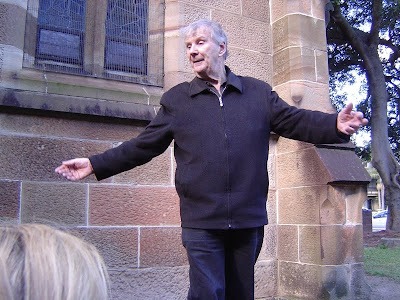 He inspired and delighted us, but one thing he said really stood out:
He inspired and delighted us, but one thing he said really stood out: "Show children how to create: the best way to do this is to show them how to grow something. Children who know how to create things never grow into adults who destroy things."



 Additional food planted on the first community plant-in day (the following plants relate to the areas on the drawing that we've labelled annuals and/or herbs):
Additional food planted on the first community plant-in day (the following plants relate to the areas on the drawing that we've labelled annuals and/or herbs):Food Forest on ABC TV from Patrick Jones on Vimeo.
There are a few mistakes in this reportage, namely the exclusion of the entire Artist as Family (Meg Ulman, Patrick Jones and Zephyr Ogden Jones); they spoke to Patrick and labelled him "Patrick White, Garden Artist"; and the church grounds where the forest is planted is St Michael's not St Stephen's, as reported.
 We still had a few more things to do such as finish off mulching and say goodbye to our microbial friends in the soil, who it's been a privilege getting to know.
We still had a few more things to do such as finish off mulching and say goodbye to our microbial friends in the soil, who it's been a privilege getting to know. We then hammered stakes around the Forest's circumference and secured the bunting, which we won't remove until late August when the MCA show opens.
We then hammered stakes around the Forest's circumference and secured the bunting, which we won't remove until late August when the MCA show opens. We then dilly dallied. We took some more photos. We chatted to a few more passing residents about their hopes for the work. We sat down. We stood up. We chatted to the church congregation as they left their Sunday service.
We then dilly dallied. We took some more photos. We chatted to a few more passing residents about their hopes for the work. We sat down. We stood up. We chatted to the church congregation as they left their Sunday service. Thank you so much to everyone who helped in making this work come about.
Thank you so much to everyone who helped in making this work come about.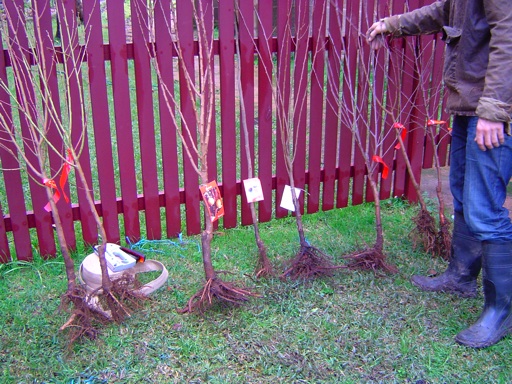 The ground was extra soft because of all the rain we have had, making the holes easy to dig.
The ground was extra soft because of all the rain we have had, making the holes easy to dig.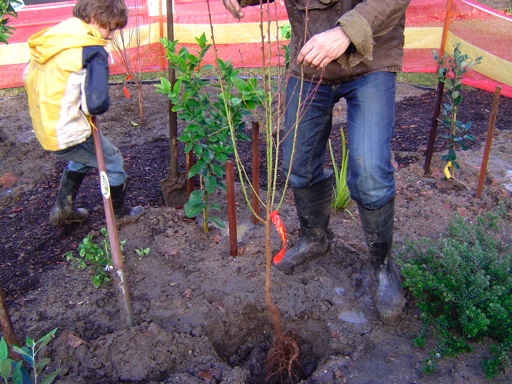 This is Richard and Heidi. We only found this ground at all because of Heidi. When we had the idea to plant a Food Forest, we had great difficulty finding some land. Heidi, a local resident heard we were looking and suggested we approach St Michael's. The rest, as they say, is history. In the making. Thank you, Heidi!
This is Richard and Heidi. We only found this ground at all because of Heidi. When we had the idea to plant a Food Forest, we had great difficulty finding some land. Heidi, a local resident heard we were looking and suggested we approach St Michael's. The rest, as they say, is history. In the making. Thank you, Heidi!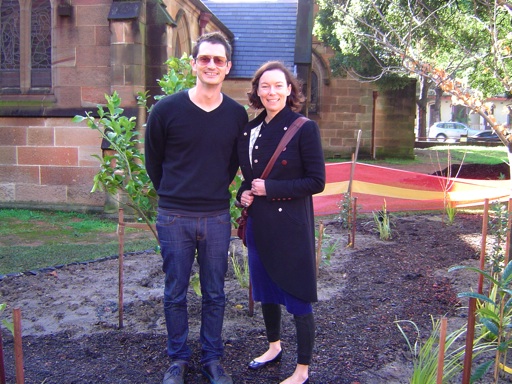 After saying goodbye to Heidi and Richard we spent a few hours mulching the Forest floor, leaving a meter around the periphery bare so people know where to settle their plants during tomorrow's Plant-In.
After saying goodbye to Heidi and Richard we spent a few hours mulching the Forest floor, leaving a meter around the periphery bare so people know where to settle their plants during tomorrow's Plant-In.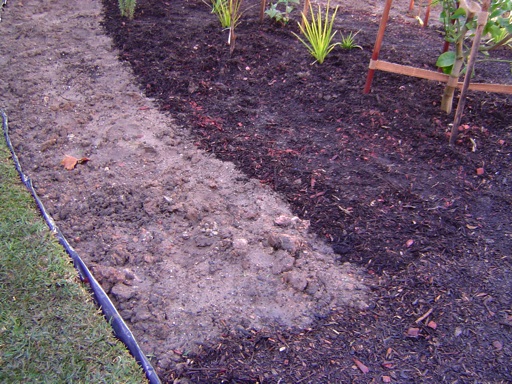 Just before lunch we went out to the Marrickville Community Nursery and picked up some Pigface, Whiteroot, Coastal Rosemary and native parsnip, which we are going to plant tomorrow in the Forest's outer ring.
Just before lunch we went out to the Marrickville Community Nursery and picked up some Pigface, Whiteroot, Coastal Rosemary and native parsnip, which we are going to plant tomorrow in the Forest's outer ring. So people can identify what's what, we then wrote each plant's name on a small copper tag and hung it on the corresponding tree.
So people can identify what's what, we then wrote each plant's name on a small copper tag and hung it on the corresponding tree.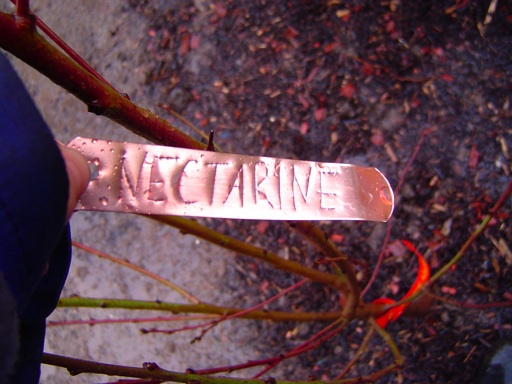
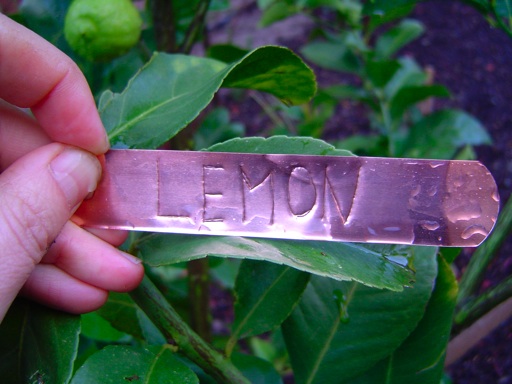 It's rained nearly every day we have worked on the Forest. But this afternoon's downpour was too heavy to work in, even for us Victorians. So it was tools down, and bottoms up at a hotel around the corner.
It's rained nearly every day we have worked on the Forest. But this afternoon's downpour was too heavy to work in, even for us Victorians. So it was tools down, and bottoms up at a hotel around the corner.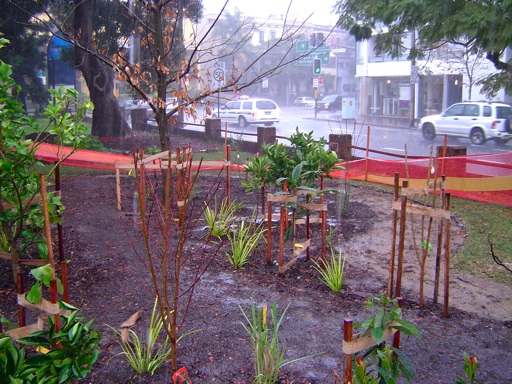 We will be on site tomorrow from 10am to 4pm come rain or shine. Come one and come all!
We will be on site tomorrow from 10am to 4pm come rain or shine. Come one and come all!


 And dianella and lomandra longifolia, the latter whose leaves contain a fibre that can be used in basket-making, weaving and to make string. Their flowers can be eaten raw, or dried and ground to make a flour for dense cakes.
And dianella and lomandra longifolia, the latter whose leaves contain a fibre that can be used in basket-making, weaving and to make string. Their flowers can be eaten raw, or dried and ground to make a flour for dense cakes. We also planted a variety of citrus: grapefruit, mandarin, lime, lemon, orange and kumquat.
We also planted a variety of citrus: grapefruit, mandarin, lime, lemon, orange and kumquat. We also planted feijoas, coastal rosemary, lilly pilly, Brazilian guava, Hawaiian guava, avocados, lemon grass, loquat and cherimoya, which Mark Twain described as, "the most delicious fruit known."
We also planted feijoas, coastal rosemary, lilly pilly, Brazilian guava, Hawaiian guava, avocados, lemon grass, loquat and cherimoya, which Mark Twain described as, "the most delicious fruit known." With all the rain and planting the ground was getting pretty muddy, so we barrowed some mulch to make a path.
With all the rain and planting the ground was getting pretty muddy, so we barrowed some mulch to make a path. Then we cut down some trees and whittled them into stakes. Ha ha, not likely, although maybe one day the Forest will be abundant enough.
Then we cut down some trees and whittled them into stakes. Ha ha, not likely, although maybe one day the Forest will be abundant enough. We fastened some hessian tree-tie to them, to support and guard each plant.
We fastened some hessian tree-tie to them, to support and guard each plant. Just as the rain cleared, St Michael's Rev Francis Chalwell (right) came to say hello and introduce Bishop Alan Stewart.
Just as the rain cleared, St Michael's Rev Francis Chalwell (right) came to say hello and introduce Bishop Alan Stewart. And then a little later, Greens Senator, Scott Ludlam, Sustainable Cities portfolio, (right) and Tony Hickey, Greens candidate for the Federal seat of Sydney, (middle), came to see the Forest.
And then a little later, Greens Senator, Scott Ludlam, Sustainable Cities portfolio, (right) and Tony Hickey, Greens candidate for the Federal seat of Sydney, (middle), came to see the Forest.  Dignitaries abounded, but the really very special guest was a visit by a beautiful native minor bird who danced around the oranges and had us entranced.
Dignitaries abounded, but the really very special guest was a visit by a beautiful native minor bird who danced around the oranges and had us entranced. As well as updating this blog with the Forest activity, we have been documenting the progress on digital film, which we will edit into a short piece a little later on. Watch this space.
As well as updating this blog with the Forest activity, we have been documenting the progress on digital film, which we will edit into a short piece a little later on. Watch this space.